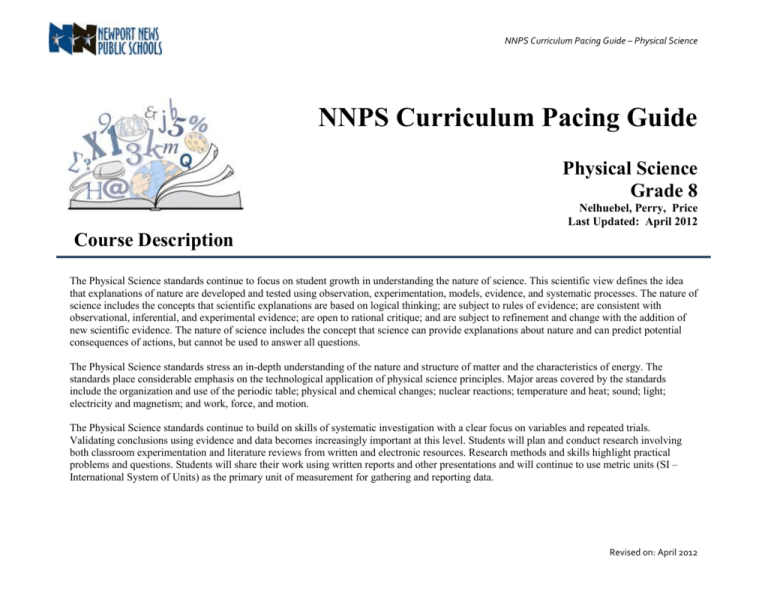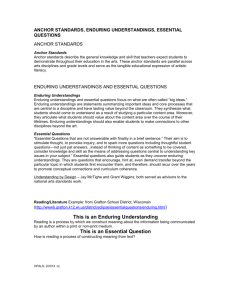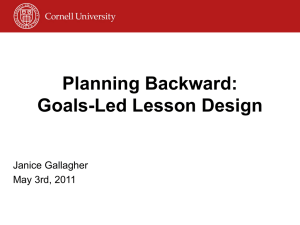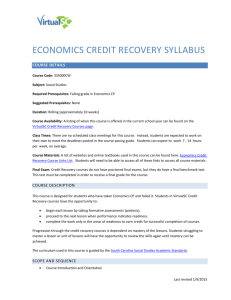PHYSICAL_SCIENCE_PACING_GUIDE
advertisement

NNPS Curriculum Pacing Guide – Physical Science NNPS Curriculum Pacing Guide Physical Science Grade 8 Nelhuebel, Perry, Price Last Updated: April 2012 Course Description The Physical Science standards continue to focus on student growth in understanding the nature of science. This scientific view defines the idea that explanations of nature are developed and tested using observation, experimentation, models, evidence, and systematic processes. The nature of science includes the concepts that scientific explanations are based on logical thinking; are subject to rules of evidence; are consistent with observational, inferential, and experimental evidence; are open to rational critique; and are subject to refinement and change with the addition of new scientific evidence. The nature of science includes the concept that science can provide explanations about nature and can predict potential consequences of actions, but cannot be used to answer all questions. The Physical Science standards stress an in-depth understanding of the nature and structure of matter and the characteristics of energy. The standards place considerable emphasis on the technological application of physical science principles. Major areas covered by the standards include the organization and use of the periodic table; physical and chemical changes; nuclear reactions; temperature and heat; sound; light; electricity and magnetism; and work, force, and motion. The Physical Science standards continue to build on skills of systematic investigation with a clear focus on variables and repeated trials. Validating conclusions using evidence and data becomes increasingly important at this level. Students will plan and conduct research involving both classroom experimentation and literature reviews from written and electronic resources. Research methods and skills highlight practical problems and questions. Students will share their work using written reports and other presentations and will continue to use metric units (SI – International System of Units) as the primary unit of measurement for gathering and reporting data. Revised on: April 2012 NNPS Curriculum Pacing Guide – Physical Science Semester 1 Estimated Enduring Understandings Time Unit Title: Unit 01 Nature of Science and Matter 16 Blocks Scientists study and compare organisms, places, ideas, events and relationships to make sense of the world Scientists ask questions, collecting evidence, and analyzing/interpreting evidence to answer questions, solve problems, and or make decisions. Objects are made of the same basic particles, but they combine in different ways to make materials with a variety of physical/chemical properties. Visual, observable behavior & properties may be very different from the behavior and properties of the particles @ nanoscale. Essential Questions How does technology help us study and compare organisms, places, ideas, events and relationships to make sense of the world? How is evidence used to solve problems and make decisions? How have models been used to understand atomic structure & behavior of materials and how/why has that understanding changed? To what extent does understanding fission & fusion help us solve problems and make decisions? Topics Standards Lab safety & Scientific investigations & Science projects Measuring (SI Units) and interpreting data History of atomic theory Particle nature of matter & atomic structure States of Matter: Solids, liquids, gas, & plasma and phase changes. Mass, volume, & density Characteristics of matter - Physical properties; (density, solubility, odor, melting point, boiling point, color, shape) and Chemical properties: (acidity, basicity, combustibility, reactivity ) Periodic table - introduction Elements, compounds, mixtures, solutions (heterogeneous, homogeneous) Classification of compounds – organic, Inorganic, acids, bases, salts & pH Modern atomic structure at nanoscale PS.1 a-n PS.3 a-b PS.2 a-f Revised on: April 2012 NNPS Curriculum Pacing Guide – Physical Science Estimated Enduring Understandings Time Unit Title: Unit 02 Chemistry 15 Blocks Essential Questions Matter undergoes chemical What rules define how and physical changes but scientists use the periodic mass and energy are table as a tool? conserved in a closed How does studying cause and system effect help us understand Chemical changes can be changes in matter and energy? described with equations Nuclear reactions change small amounts of matter into energy Topics Standards Neutral atoms, ions, isotopes Organization and use of Periodic Table Classification of elements into families/groups and periods Metals, Metalloids, & Nonmetals Nature of bonding (Ionic & Covalent) Symbols and formulas Write and Balance Chemical Equations Law of Conservation of Matter Physical Changes Chemical changes Nuclear Reactions Endothermic & exothermic reactions PS. 1 a–n PS. 4 a–c PS.5 a-c Revised on: April 2012 NNPS Curriculum Pacing Guide – Physical Science Estimated Enduring Understandings Time Unit Title: Unit 03 Energy and Transformations 11 Blocks Matter and energy can be described and changed in a variety of ways. Scientists manipulate matter and energy in order to affect the world around them. Essential Questions Topics How can you recognize, analyze and communicate energy transfer and it’s applications? How do the principles of thermal energy apply to the nature of science? 2 Blocks Review & Testing Review & Testing 1. Standards States and Forms of energy – kinetic, potential (mass, velocity, position); radiant, thermal, chemical, electrical, mechanical, nuclear Transformation of energy Temperature & thermal energy Conduction, convection, radiation & applications of thermal energy transfer Celsius & Kelvin temperature scales & absolute zero Phase changes & energy transfer – F.P., M.P, B.P., vaporization, condensation Heat, temperature and particle motion PS.1 a-n PS.5 c PS.6 a-b PS.7a-d Review & Testing Revised on: April 2012 NNPS Curriculum Pacing Guide – Physical Science Ssemester 2 (37 Blocks) Estimated Enduring Understandings Time Unit Title: Unit 04 Motion, Forces, Work 13 Blocks Newton used a variety of formulas to describe motion. Graphs are a picture of the relationship between time and motion. Essential Questions How are work, force, and motion related to everyday life? How do machines make work easier? Standar ds Topics Newton’s laws of Motion Work, force, mechanical advantage Efficiency & power Applications of work, force, & motion Speed, velocity, acceleration Force, mass, weight, Machines, effort, friction, output PS.10a-d Unit Title: Unit 05 Electricity and Magnetism 9 Blocks Electricity is related to magnetism There are many applications of electricity and magnetism How has understanding electromagnetic theory changed over time and affected our lives? To what extent is a magnetic field related to an electric current & vice versa? Estimated Enduring Understandings Time Unit Title: Unit 06 Waves, Light, & Sound Static & current Electricity Insulators, conductors, semi-conductors Series and parallel circuits Magnetic fields & how they can be used construct simple circuits to determine the relationship between voltage, resistance, current Motors, generators, electromagnets, and other applications of electromagnetic technology Transistors, solar cells, diodes, & LEDs, Friction, resistance, and heat Essential Questions Topics PS.11a-d Standards Revised on: April 2012 NNPS Curriculum Pacing Guide – Physical Science Estimated Time 11 Blocks 4-11 Blocks Enduring Understandings Waves exhibit certain characteristics that impact every aspect of our world. How does understanding wave characteristics explain the behavior of light, and sound? Essential Questions Topics Standards Wavelength, frequency, speed, amplitude, rarefaction, compression, and interference of waves Resonance and technological applications of sound (ultrasound) Sound & longitudinal waves - Mechanical waves Light and transverse waves, vacuum Lenses, mirrors & images – plane, concave, convex Electromagnetic spectrum Technological applications of light Reflection, refraction, absorption, transmission, emission (energy transfer) Diffraction, interference, convergence, divergence, Review & Test Please check with your school administrator to see when the SOL test is scheduled and adjust this review time accordingly. PS. 8 a-d PS. 9 a-e 6th. 1-9 LS. 1-14 PS. 1-11 Revised on: April 2012







